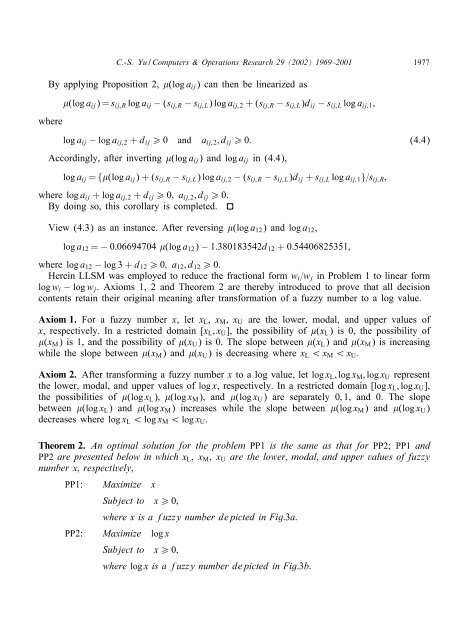A GP-AHP method for solving group decision-making fuzzy AHP ...
A GP-AHP method for solving group decision-making fuzzy AHP ...
A GP-AHP method for solving group decision-making fuzzy AHP ...
Create successful ePaper yourself
Turn your PDF publications into a flip-book with our unique Google optimized e-Paper software.
C.-S. Yu / Computers & Operations Research 29 (2002) 1969–2001 1977<br />
By applying Proposition 2, (log aij) can then be linearized as<br />
where<br />
(log aij)=sij;R log aij − (sij;R − sij;L) log aij;2 +(sij;R − sij;L)dij − sij;L log aij;1;<br />
log aij − log aij;2 + dij ¿ 0 and aij;2;dij ¿ 0: (4.4)<br />
Accordingly, after inverting (log aij) and log aij in (4.4),<br />
log aij = { (log aij)+(sij;R − sij;L) log aij;2 − (sij;R − sij;L)dij + sij;L log aij;1}=sij;R;<br />
where log aij + log aij;2 + dij ¿ 0; aij;2;dij ¿ 0.<br />
By doing so, this corollary is completed.<br />
View (4.3) as an instance. After reversing (log a12) and log a12,<br />
log a12 = − 0:06694704 (log a12) − 1:380183542d12 +0:54406825351;<br />
where log a12 − log 3+d12 ¿ 0; a12;d12 ¿ 0.<br />
Herein LLSM was employed to reduce the fractional <strong>for</strong>m wi=wj in Problem 1 to linear <strong>for</strong>m<br />
log wi − log wj. Axioms 1, 2 and Theorem 2 are thereby introduced to prove that all <strong>decision</strong><br />
contents retain their original meaning after trans<strong>for</strong>mation of a <strong>fuzzy</strong> number to a log value.<br />
Axiom 1. For a <strong>fuzzy</strong> number x, let xL; xM; xU are the lower, modal, and upper values of<br />
x, respectively. In a restricted domain [xL;xU], the possibility of (xL) is 0, the possibility of<br />
(xM) is 1, and the possibility of (xU) is 0. The slope between (xL) and (xM) is increasing<br />
while the slope between (xM) and (xU) is decreasing where xL ¡xM ¡xU.<br />
Axiom 2. After trans<strong>for</strong>ming a <strong>fuzzy</strong> number x to a log value, let log xL; log xM; log xU represent<br />
the lower, modal, and upper values of log x, respectively. In a restricted domain [log xL; log xU],<br />
the possibilities of (log xL); (log xM), and (log xU) are separately 0; 1, and 0. The slope<br />
between (log xL) and (log xM) increases while the slope between (log xM) and (log xU)<br />
decreases where log xL ¡ log xM ¡ log xU.<br />
Theorem 2. An optimal solution <strong>for</strong> the problem PP1 is the same as that <strong>for</strong> PP2; PP1 and<br />
PP2 are presented below in which xL; xM; xU are the lower; modal; and upper values of <strong>fuzzy</strong><br />
number x; respectively;<br />
PP1: Maximize x<br />
Subject to x ¿ 0;<br />
where x is a <strong>fuzzy</strong> number depicted in Fig:3a:<br />
PP2: Maximize log x<br />
Subject to x ¿ 0;<br />
where log x is a <strong>fuzzy</strong> number depicted in Fig:3b:









